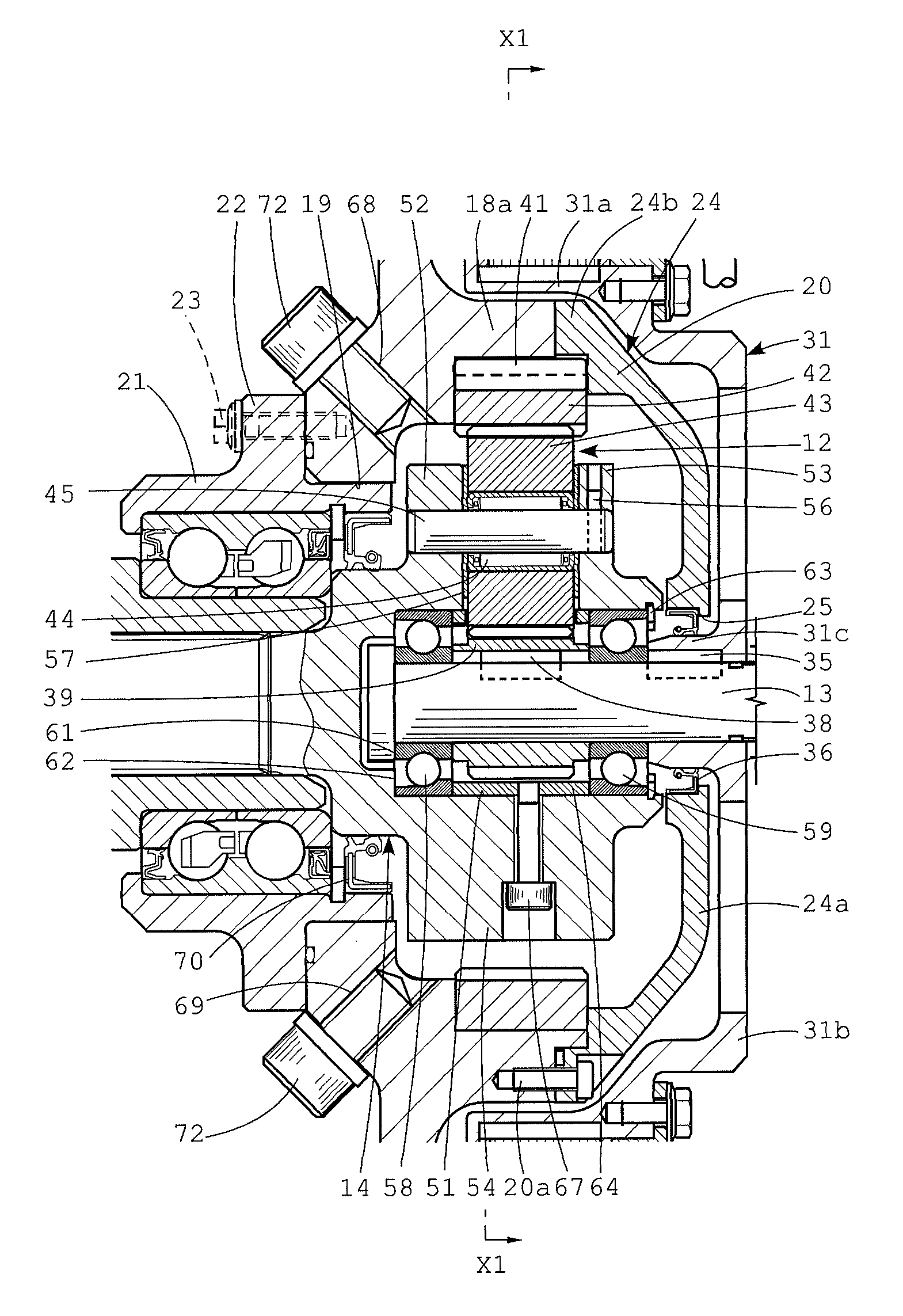Drive device for electric vehicle
a technology for electric vehicles and drive devices, which is applied in the direction of electric propulsion mounting, transportation and packaging, and gearing, etc. it can solve the problems of deterioration of occurrence of deterioration of the durability of the bearings, so as to suppress the rotational noise of the bearings and the rotational accuracy of the input sha
- Summary
- Abstract
- Description
- Claims
- Application Information
AI Technical Summary
Benefits of technology
Problems solved by technology
Method used
Image
Examples
embodiment 1
[0034]A drive device for an electric vehicle relating Embodiment 1 includes, as principal components, an electric motor 11, a speed reduction unit 12 which is driven by the output power of the electric motor 11, a hub unit 15 which is rotated by an output member 14 coaxial with an input shaft 13 of the speed reduction unit 12, and a housing 16 which accommodates the electric motor 11 and the speed reduction unit 12, as shown in FIG. 1.
[0035]The above-described housing 16 includes a cylindrical portion 17 and a front end portion 18 in the radial direction, which is provided at the front end of the cylindrical portion (the end portion of an outboard side, or an end portion on the left side of the figure). A central portion of the front end portion 18 is opened, and a rear end portion of an outer member 21 of the hub unit 15 is fitted into an opening portion 19 so that a flange 22 is secured to the front end portion 18 with a bolt 23.
[0036]A partition base portion 18a, which is concent...
embodiment 2
[0081]Embodiment 2 shown in FIG. 7 differs in the configuration of the hub unit 15 compared with the above-described Embodiment 1. That is, the flange 22 of the outer member 21 of the hub unit 15 in this case is formed to have a larger diameter than that of the flange 22 (see FIG. 1) of the above-described Embodiment 1.
[0082]A flange cylindrical portion 32 projecting in the axial direction is provided in the inner side surface of the flange 22 with a larger diameter. The flange cylindrical portion 32 extends over an outer radial surface of the flange 52 on the outboard side of the output member 14. The flange cylindrical portion 32 is fitted to an inner radial surface of the opening hole 19 of the front end portion 18 of the housing 16.
[0083]Since, compared with the case of Embodiment 1, the opening hole 19 is formed to have a large inner diameter, it is easy to fabricate the partition 24 which is integrated with the front end portion 18, in the case of this Embodiment 2. For this r...
embodiment 3
[0089]Embodiment 3 shown in FIGS. 8 to 10 differs from Embodiment 1 in the configurations of the hub unit 15, the rotation angle sensor 75, the power supply terminal box 76, and the connector insertion portion 78.
[0090]That is, the hub unit 15 in this case is formed such that the flange 22 of the outer member 21 has a larger diameter than in the case of Embodiment 1. Since, for this reason, the opening hole 19 of the front end portion 18 of the housing 16 is formed to have a larger inner diameter as in the case of Embodiment 2, it is possible to form the partition 24 integrally with the front end portion 18.
[0091]The ball 89a on the outboard side constituting the hub bearing is placed between the track groove provided in the outer radial surface of the inner member 46 and the track groove provided in the inner radial surface of the outer member 21. Further, the ball 89b on the inboard side is placed between the track grove provided in the outer radial surface of the output member 14...
PUM
 Login to View More
Login to View More Abstract
Description
Claims
Application Information
 Login to View More
Login to View More - R&D
- Intellectual Property
- Life Sciences
- Materials
- Tech Scout
- Unparalleled Data Quality
- Higher Quality Content
- 60% Fewer Hallucinations
Browse by: Latest US Patents, China's latest patents, Technical Efficacy Thesaurus, Application Domain, Technology Topic, Popular Technical Reports.
© 2025 PatSnap. All rights reserved.Legal|Privacy policy|Modern Slavery Act Transparency Statement|Sitemap|About US| Contact US: help@patsnap.com



